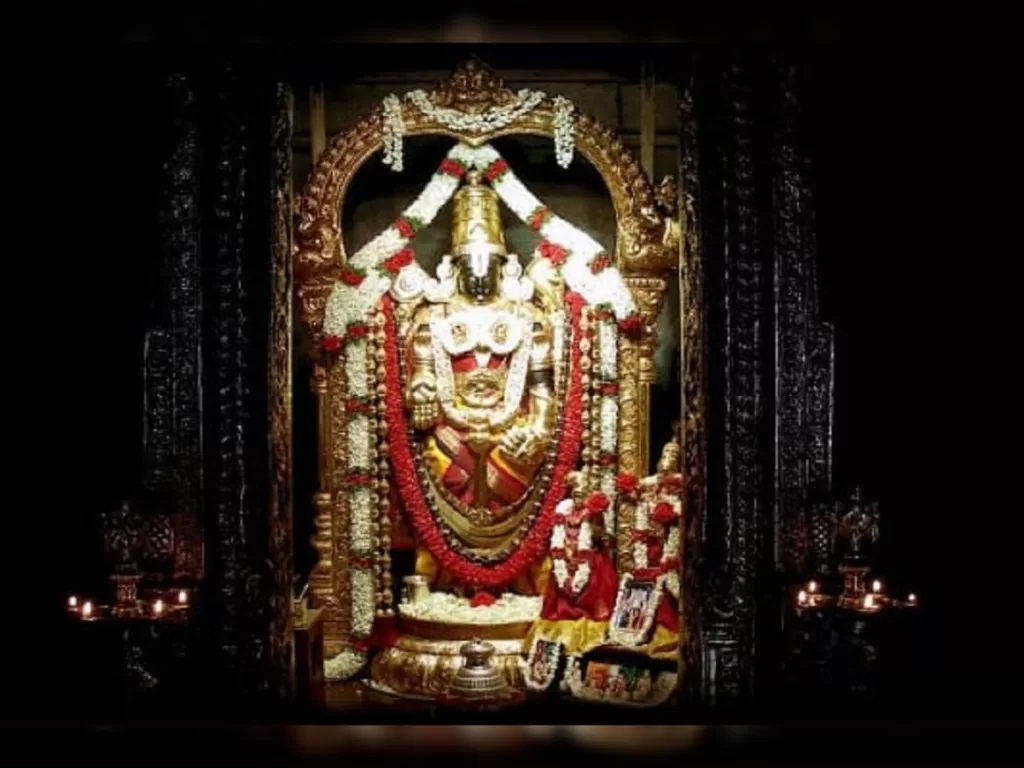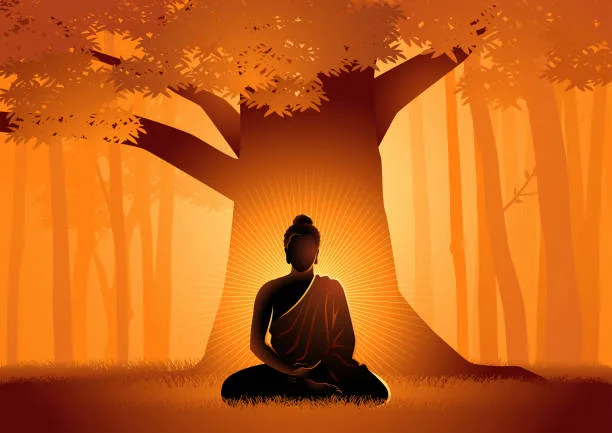Tirupati Balaji Temple, also known as Sri Venkateswara Swamy Temple, is one of the most significant and revered Hindu pilgrimage destinations in India. Located in the southeastern state of Andhra Pradesh, the temple is situated atop the seven hills of Tirumala, which are believed to represent the seven heads of the serpent Adisesha, on which Lord Vishnu, the preserver of the universe, reclines.
The temple is dedicated to Lord Venkateswara, an incarnation of Lord Vishnu, who is worshipped as the supreme deity by millions of devotees across the world. The temple complex is spread over an area of 26.7 square kilometers and comprises several shrines, mandapams, gopurams, and other structures. The main shrine, where Lord Venkateswara is enshrined, is located at the apex of the temple complex and is known as the Garbhagriha or sanctum sanctorum.
The history
The Tirupati Balaji Temple is believed to have been built in the 12th century AD by the kings of the Vijayanagara Empire. The temple underwent several renovations and additions over the centuries, and today, it stands as a marvel of Dravidian architecture and design. The temple complex is adorned with intricate carvings, sculptures, and paintings that depict the stories and legends of Hindu mythology.
The temple attracts millions of devotees every year from all parts of India and the world. The worship at the temple is conducted according to the Vaikhanasa Agama, which is a set of rules and regulations prescribed for the worship of Lord Vishnu. The temple follows a strict ritualistic worship protocol, which includes daily pujas, abhishekams, alankarams, and other forms of worship.

The significance of Tirupati Balaji Temple in Hinduism
The Tirupati Balaji Temple holds a significant place in the Hindu religion and mythology. It is believed that Lord Venkateswara, the presiding deity of the temple, came down to earth in his avatar form to redeem mankind from the cycle of birth and death. According to the Puranas, Lord Venkateswara took the form of a human to marry his consort, Padmavati and stayed on earth to bless his devotees.
The temple is also believed to be one of the eight Swayambhu Kshetras or self-manifested shrines of Lord Vishnu, which are considered to be the holiest pilgrimage sites for Vaishnavites. It is said that the temple was built at the exact spot where Lord Venkateswara appeared in front of his devotee, Saint Ramanujacharya, and revealed his divine form.
Legends that are associated
The temple is also associated with several legends and stories that add to its significance in Hinduism. According to one legend, the seven hills of Tirumala are said to have been formed by Lord Varaha, an incarnation of Lord Vishnu, who lifted the earth from the ocean to save it from destruction. Another legend states that the temple was built by the sage Bhrigu, who was sent by Lord Brahma to find the most superior deity among the Hindu trinity.
The temple is also associated with the famous story of Lord Venkateswara borrowing money from Kubera, the god of wealth, to pay for his wedding expenses. The story goes that Lord Venkateswara took a loan from Kubera and is still repaying it to this day, which is why devotees donate money and offerings at the temple to help clear the debt.
Worship and rituals at Tirupati Balaji Temple
The worship and rituals at Tirupati Balaji Temple are deeply rooted in the Vaikhanasa Agama, which is a set of rules and regulations prescribed for the worship of Lord Vishnu. The temple follows a strict ritualistic worship protocol, which includes daily pujas, abhishekams, alankarams, and other forms of worship.
The temple is open for darshan from 3 am in the morning to 1 am the next day, and the worship begins with Suprabhatam, which is a hymn sung in praise of Lord Venkateswara. This is followed by a series of pujas, including Thomala Seva, Archana, and Sahasra Namarchana, which involve offering flowers, fruits, and other items to the deity while reciting his name and mantras.
The most significant ritual at the temple is the Tiruppavada Seva, which is performed daily after the second bell in the morning. During this ritual, the deity is adorned with a dhoti and turban and is offered food consisting of rice, curd, and jaggery, which is believed to be his favorite. The temple also offers several other sevas, including Kalyanotsavam, Visesha Puja, and Arjitha Brahmotsavam, which are performed on special occasions and festivals.

Another important ritual at the temple is the Abhishekam, which is performed to cleanse and purify the idol of Lord Venkateswara. The abhishekam involves pouring milk, honey, ghee, and other sacred substances over the idol while chanting mantras and hymns. The temple also performs the Sahasra Kalasabhishekam, which is a grand abhishekam that involves pouring sacred water from 1008 vessels over the idol.
The temple also has a unique practice of offering hair as a form of sacrifice to the deity. Devotees offer their hair to the temple as a symbol of surrender and devotion, and the hair is later auctioned off to raise funds for the temple’s maintenance and development.
Devotees visiting the temple can also participate in the prasadam distribution, which involves distributing food to the devotees after the daily pujas. The temple serves over 50,000 meals every day, which are prepared using traditional methods and served to devotees free of cost.
The temple also has a tradition of doling out laddus, a sweet made of gram flour, ghee, and sugar, as prasadam. The laddus are considered to be highly auspicious and are believed to have medicinal properties. The temple has a dedicated laddu counter, which serves over 1.5 lakh laddus every day.
The temple also celebrates several festivals throughout the year, including Brahmotsavam, Vaikunta Ekadasi, and Rathotsavam. These festivals are celebrated with great pomp and show, and devotees from all over the world flock to the temple to participate in the festivities and seek the blessings of Lord Venkateswara.
The worships and rituals at Tirupati Balaji Temple are deeply rooted in Hindu mythology and are an integral part of the temple’s significance in Hinduism. The temple follows a strict ritualistic worship protocol, which is designed to purify and cleanse the devotee’s mind and soul and connect them with the divine.
The temple’s traditions and practices have been passed down through generations and continue to attract millions of devotees every year, making it one of the most revered and significant pilgrimage destinations in India.
Best time to visit Balaji temple
The best time to visit the Tirupati Balaji Temple and offer prayers depends on personal preference and the purpose of the visit. However, there are some general guidelines that can help visitors plan their trip.
One of the most popular times to visit the temple is during the Brahmotsavam festival, which is celebrated in September/October every year. This is a nine-day festival that involves various rituals, processions, and performances, and is considered to be one of the most significant festivals at the temple. Many devotees plan their visit around this time to participate in the festivities and seek the blessings of Lord Venkateswara.
Another popular time to visit the temple is during the winter months, from November to February. The weather during this time is pleasant, and the crowds are relatively smaller compared to the summer months. This can make it easier to get darshan and offer prayers without the long queues and crowds.
The summer months, from March to June, can be quite hot and humid, and the temple can get crowded with tourists and pilgrims. However, this is also a popular time to visit the temple, as it coincides with several important festivals such as Ugadi, Vaikunta Ekadasi, and Rama Navami.
It is important to note that the temple can get extremely crowded during weekends, public holidays, and special events, which can lead to long waiting times and queues. Visitors are advised to plan their visit accordingly and arrive early in the morning to avoid crowds.
In terms of offering prayers, visitors can offer prayers and perform various rituals at any time during the temple’s opening hours, which are from 3 am in the morning to 1 am the next day. It is recommended to participate in the daily pujas and rituals, such as Suprabhatam, Thomala Seva, and Tiruppavada Seva, as they are considered to be highly auspicious and beneficial for spiritual growth.
Overall, the best time to visit the Tirupati Balaji Temple and offer prayers depends on personal preference and the purpose of the visit. Visitors should plan their trip well in advance, taking into consideration the weather, crowds, and festivals, to ensure a memorable and fulfilling experience.
Do I have to wear any particular attire or dress to visit the Balaji temple?
Yes, visitors to the Tirupati Balaji Temple are required to dress modestly and follow a dress code. The dress code is designed to maintain the sanctity and purity of the temple premises and to show respect to the deity.
For men, it is recommended to wear traditional attire such as a dhoti and shirt, or a kurta and pajama. Western wear such as shorts, jeans, and t-shirts is not allowed inside the temple premises. Men can also wear angavastram or a shawl on their shoulders.
For women, it is recommended to wear traditional attire such as sarees, salwar kameez, or churidar. Western wear such as shorts, skirts, and sleeveless tops is not allowed inside the temple premises. Women should also cover their heads with a dupatta or shawl.
It is important to note that footwear is not allowed inside the temple premises. Visitors are required to remove their shoes or sandals before entering the temple and can either carry them or deposit them in the shoe stand provided by the temple authorities.
Overall, visitors are expected to dress modestly and show respect to the deity and the temple premises. Failure to follow the dress code may result in denial of entry to the temple.

Conclusion
In conclusion, a visit to the Balaji Temple is not just a religious experience, but a journey through history and culture. The temple’s awe-inspiring architecture, stunning natural surroundings, and spiritual aura create a tranquil and serene atmosphere that leaves a lasting impression on all who visit. Devotees believe that the blessings of Lord Venkateswara are abundant here, and many return to the temple time and time again to seek solace and divine intervention. Whether you are a believer or not, the Balaji Temple is a must-visit destination for anyone seeking a deeper connection with India’s rich heritage and spirituality.
Disclaimer:
The author’s views are his or her own. The facts and opinions in the article have been taken from various articles and commentaries available in the online media and Eastside Writers does not take any responsibility or obligation for them.
Note: Contact our Writers at www.eastsidewriters.com for writing Blogs/Articles on any niche. We have experts in various domains from Technology to Finance and from Spirituality to Lifestyle and Entertainment.






